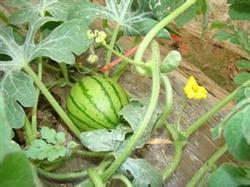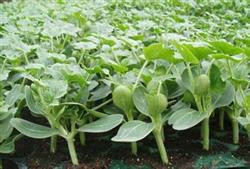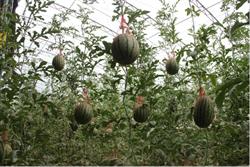Three measures for watermelon post-flowering management

If the flowering and fruiting period of artificial pollination watermelon is in the low temperature and rainy season, it is more difficult to set fruit. On the one hand, the low temperature, overcast and rainy weather is not conducive to the activities of pollinators such as bees; on the other hand, Rain Water is very easy to wash away the pollen on the female flower stigma or break the pollen and lose the ability to germinate, so it is difficult to complete the fertilization process. Therefore, artificial pollination is very necessary at this time. The specific method is: according to the local weather conditions, in the afternoon or evening before rainfall, cover the female and male flowers blooming the next day in a paper tube, and then remove the paper tube for artificial pollination when it blossoms the next morning. When pollinating, first pick the male flowers, peel off the petals, leave the anthers, and then gently apply the pollen to the stigma of the female flowers. In the process of pollination, the action should be light, do not touch the young melon with your hands, so as to avoid mechanical damage and affect fruit setting. After pollination, the female flower is covered with a paper tube. The paper tube was removed after 3 days so as not to affect the fruit expansion. During flowering and pollination, in case of short showers, dry pollen can be used on the stigma of female flowers without stagnant water two hours after the rain. Generally, it rains 3 hours after pollination, which has little effect on fruit setting. If it rains for less than 3 hours, it should be rewarded once. In cloudy and rainy weather, male flowers that are about to bloom can also be picked and left indoors to bloom. The female flower sleeve, when pollinating the next morning, take off the female flower paper tube, take the female flower open in the room for pollination, and the sleeve protects the female flower after pollination. The selection of proper melon retention and watermelon node position has a great relationship with the fruit size, yield and commodity quality. The first female flower of the main vine is generally not used because of its low node position, small fruit, thick skin and incorrect fruit shape; the high node leaves melon mature late, and the plant growth often causes fruit setting difficulties, so it is seldom used. In production, the second and third female flowers on the main vine are generally selected, about 15-20. The use of late-maturing varieties and multi-vine pruning, retained melon node position can be higher, early-maturing varieties and early-maturing dense planting less vine pruning, retained melon node position should be lower. Before and after fruit setting, in case of low temperature, drought, lack of light and other unfavorable conditions, or when the plant growth is too weak, the position of melon node is higher. When the main vine is injured and cannot set fruit, the first and second female flowers of the lateral vine can be selected to stay. The number of remaining melons in a watermelon varies according to the cultivation form, variety, planting density and other factors. Generally speaking, under the condition of medium fertilizer and water, the middle fruit type variety is used, double vines are pruned, 450 Mur500 plants per mu are planted, and one melon is suitable for each plant; those with sparse planting, small melons, three or more vines, and good conditions of fertilizer and water can retain more melons appropriately. Turning the melon means constantly changing the landing position of the fruit, so that the surface of the melon is evenly exposed to light, the skin color is the same, and the maturity of the flesh is uniform. Turning the melon is generally carried out in the middle and later stage of the melon expansion period, turning once every 8 days, and turning 2 times for 3 times. When turning melons, we should pay attention to: first, it is appropriate to turn melons on a sunny afternoon; second, turn melons along the lines on the stalk (that is, vascular bundles). Do not twist forcefully, so as not to break the stalk and stem; third, when turning the melon, use both hands, one hand to hold the tail of the fruit, the other to hold the top of the fruit, and both hands to twist gently at the same time; fourth, each time you turn the melon gently in the same direction, the angle of a turn should not be too large, in order to turn out of the original ground. It takes a certain time to judge the fruit development of mature and harvested watermelon. In general, it takes 28 mi 30 days for early mature varieties to bloom to mature female flowers, 30 min for middle mature varieties from female flowers to maturity, and 35 mi 40 days for late mature varieties. Mature and moderate watermelons have sweet taste, good color, crisp and juicy, less fiber, good flavor and good quality. At present, the main methods to judge watermelon maturity are visual method, hand touch or slapping method, marking method, specific gravity method and so on. The main results are as follows: 1. After the fruit is ripe, the peel is hard and bright, the pattern is clear, the navel and pedicel of the fruit contract and sag inward, the shade of the fruit turns yellow and rough, most of the villi on the stalk fall off, and the tendrils of two nodes before and after the fruit setting section wither, which can be used as signs of watermelon ripening. Second, hands touch or pat mature watermelons have a smooth feeling with hands, while immature watermelons feel astringent when touched with hands. In addition, when you use your hands to support melons, knock or finger play melon noodles, most of them are ripe melons if they make a low dull sound of bang, bang and bang; on the contrary, if they make a thump, thump and solid sound, they are mostly raw melons. Third, the marking method is based on the need for a certain amount of accumulated temperature and days for the maturity of each variety, and a single melon is marked after flowering and pollination. According to the accumulated temperature or days needed for each variety to mature, the maturity period was calculated. Through the combination of the date of fruit setting and the inspection of cut melon, the suitable maturity of watermelon can be ensured. Fourth, the specific gravity of ripe watermelon and water is different at room temperature. The specific gravity of water is 1, while that of general mature melons is 0.9PY 0.95. Put the watermelon into the water to observe. If the watermelon is completely sunk, it shows that it is raw; if it rises to the surface, it shows that the proportion of the melon is less than 0.9, and the watermelon is too ripe; if it does not surface much, it shows that it is ripe. In practical application, in order to accurately judge whether watermelons are mature or not, various factors should be comprehensively considered, not based on one factor alone. Harvest maturity should also be determined according to market conditions. If there is a local supply of well-done 's melons, they will be available to the market in the afternoon or the next day. Medium well's melons can be harvested from other places. At present, the quality of watermelons supplied in the market is poor, in addition to the varieties themselves and hybrid degradation and other factors, picking raw melons is an important reason, in addition to the lack of experience in identifying the maturity of watermelons, it is mainly due to human factors. some melon farmers think that early melon price is high, raw melon weight is heavy, early harvest is beneficial to later growth and fruit, without considering the impact of raw melon on quality.
- Prev

Four key steps in raising Watermelon seedlings with Hot Kang
The hot Kang seedling of watermelon has the characteristics of fast heating, uniform temperature, low cost, simple operation and so on. Strong watermelon seedlings can be cultivated in January and February when the temperature is very low, and the effect is similar to that of an electric hotbed. First, build a seedbed. First, dig a bed pool that is 4.5 meters long from east to west, 1.6 meters wide from north to south and 0.2 meters deep.
- Next

Requirements for cultivation environmental conditions of watermelon
First, the variety selection as a gift watermelon should choose small and exquisite, beautiful appearance, good quality varieties, as the main varieties, single fruit weight should be in the 1-2kg heavy varieties. If the fruit is too big or too small, it will lose the function of a gift. At present, there are mainly Huangshui jade, Xiangyu crystal, flower beauty, Xiangyu black rose, hibiscus honey,.
Related
- Moge, come on! The staff of the peasant association in the producing area of cantaloupe were frightened when the crowd gathered.
- Causes and Solutions of low Fruit setting rate of Apple
- Symptoms and control measures of passion fruit virus disease
- Fruit growing lesson: how do apple orchards keep high yields?
- Can you build orchards in the mountains? What are the pros and cons?
- How to manage the coloring period of Crisson grape?
- This paper introduces the processing technology of two kinds of fig products.
- How much is a month for retired teachers in rural areas by 2020?
- How can strawberry planting increase sugar content? We should pay attention to management in many aspects.
- What are the cultivation techniques on how to improve the yield of golden fruit?

